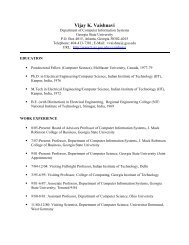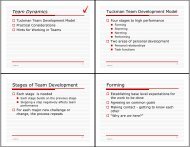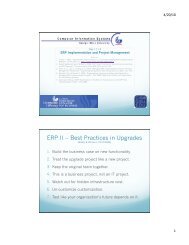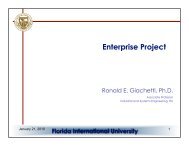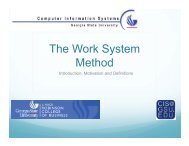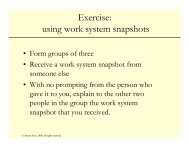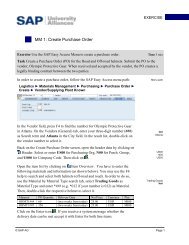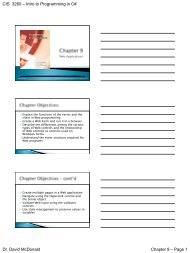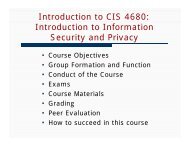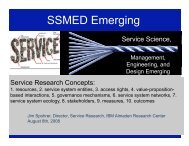The Work System Method - Department of Computer Information ...
The Work System Method - Department of Computer Information ...
The Work System Method - Department of Computer Information ...
You also want an ePaper? Increase the reach of your titles
YUMPU automatically turns print PDFs into web optimized ePapers that Google loves.
<strong>The</strong> <strong>Work</strong> <strong>System</strong> <strong>Method</strong>Introduction, Motivation andDefinitions
Definition• <strong>Work</strong>• the application <strong>of</strong> human and technicalresources to produce products andservices for internal and/or externalcustomers.
<strong>Work</strong> <strong>System</strong>• <strong>Work</strong> <strong>System</strong> - a system in which human participants and/ormachines perform work using information, technology, and otherresources to produce products and/or services for internal orexternal customers.• Typical business organizations contain work systems that procure materialsfrom suppliers, produce products, deliver products to customers, findcustomers, create financial reports, hire employees, coordinate work acrossdepartments, and perform many other functions.• Every work system can be viewed as a subsystem <strong>of</strong> a larger work system,the boundaries <strong>of</strong> a work system are treated as a carefully considereddecision by the work system modeler.• In general, the relevant work system for a particular analysis is the smallestwork system that exhibits or possesses the problem, issue, or opportunitythat prompted the analysis
Examples <strong>of</strong> <strong>Work</strong> <strong>System</strong>s(from papers by MBA students at Georgia State Univ. )Calculating rates forinsurance renewalsManaging s<strong>of</strong>twaredevelopment projectsAcquiring clients at apr<strong>of</strong>essional service firmReceiving materials at a largewarehouseApproving real estate loanapplicationsPlanning and dispatchingtrucking servicesPerforming pre-employmentbackground checksPerforming financialplanning for wealthyindividualsScheduling and trackinghealth service appointmentsOperating an engineering callcenterPurchasing advertisingservicesDetermining salary increasesCollecting and reportingsales data for a wholesaler© Steven Alter, 2009, all rights reservedPlanning for outages in keyreal time informationsystemsInvoicing for constructionwork
A Limiting Paradigm…• Viewing <strong>System</strong>s as IT-based tools that areused by users.© Steven Alter, 2010
<strong>Work</strong> systems are NOT <strong>Information</strong> <strong>System</strong>s<strong>Information</strong> <strong>System</strong>s<strong>Work</strong> systems supported by information systems7
© Steven Alter, 2010<strong>Work</strong> <strong>System</strong> Framework
the basic financial statements that defined benefit pension plans are required to provide, althoughadditional financial information may be provided. Furthermore, the Board concluded thatStatement 95 was not intended to modify the reporting requirements for those plans.16. Other employee benefit plans that are not covered by Statement 35, such as health andwelfare plans, may have characteristics similar to those <strong>of</strong> defined benefit pension plans and maypresent financial information similar to that required by Statement 35 (including the presentation<strong>of</strong> plan investments at fair value). <strong>The</strong> Board believes that those plans likewise should not berequired to provide a statement <strong>of</strong> cash flows.17. <strong>The</strong> Board does not prohibit the inclusion <strong>of</strong> a statement <strong>of</strong> cash flows with the annualfinancial statements <strong>of</strong> an employee benefit plan. In fact, the Board encourages plans to providea statement <strong>of</strong> cash flows when that statement would provide relevant information about theability <strong>of</strong> the plan to meet future obligations. For example, the Board believes that a statement<strong>of</strong> cash flows would provide relevant information about a plan's ability to meet future obligationswhen the plan invests in assets that are not highly liquid, such as real estate, or obtains financingfor its investments.Investment Companies18. Before the issuance <strong>of</strong> Statement 95, the Board considered whether investment companiesshould be required to provide a statement <strong>of</strong> cash flows as part <strong>of</strong> a full set <strong>of</strong> financialstatements. <strong>The</strong> Board recognized that information about the cash flows <strong>of</strong> certain investmentcompanies may be less important than similar information for other enterprises, but the Boarddecided that information about cash flows is relevant and that investment companies should notbe exempted from a requirement to provide a statement <strong>of</strong> cash flows.19. While the Board continues to believe that information about cash flows is relevant forinvestment companies, the Board readdressed the need for highly liquid investment companies toprovide a statement <strong>of</strong> cash flows under certain conditions. Highly liquid investment companiesare those whose assets consist predominantly <strong>of</strong> cash, securities, and other assets for which amarket is readily available. For example, open-end investment companies hold themselves outas being able to redeem their outstanding shares within seven days; therefore, they are requiredto maintain a portfolio <strong>of</strong> investments that enables them to fulfill that obligation.20. For highly liquid investment companies that do not finance investments with debt, theBoard concluded that the financial statements other than a statement <strong>of</strong> cash flows generallywould provide sufficient information for a user to assess the enterprises' liquidity, financialflexibility, pr<strong>of</strong>itability, and risk. However, for investment companies that invest in assets forwhich a market is not readily available or that finance investments with debt, the Board believesthat a statement <strong>of</strong> cash flows would provide relevant information about the enterprises'investing and financing activities to assist users in those assessments.Copyright © 1989, Financial Accounting Standards BoardNot for redistributionPage 11
Intermediate Products and Services§ intermediate products and services --used by other activities within thework system.§ not considered to the products and services <strong>of</strong> the work systemunless they are received and used by the customers <strong>of</strong> the worksystem for some purpose outside <strong>of</strong> the work system.§ E.g., assume that a loan approval process produces a formalevaluation <strong>of</strong> a loan.§ <strong>The</strong> approval is considered to be among the products andservices <strong>of</strong> the work system if it goes to a work system customerfor some purpose outside <strong>of</strong> the work system.§ If the approval process is only used to make a decision in asubsequent activity and then discarded; it is an intermediateprocess.
<strong>Information</strong>§ Includes codified and non-codified information used and created asparticipants perform their work.§ Codified information is the pre-defined information used in trackingpackages, entering orders, and performing repetitive financialtransactions.§ In each case, each data item must be defined precisely, and theinformation is usually processed using explicit rules.§ Uncodified information includes computerized or handwrittendocuments, verbal agreements, and formal or informal conversations.<strong>Information</strong> may or may not be computerized.§ Knowledge can be viewed as a special case <strong>of</strong> information.§ Explicit knowledge is recorded in documents, images, rules, andother forms.§ Tacit knowledge exists in people’s heads and is not explicit.
Technologies§ Tools that help people work more efficiently or thatperform automated work steps autonomously.§ Some technologies, such as search engines, cell phones,spreadsheet s<strong>of</strong>tware, and automobiles, are generalpurposebecause they can be applied in a wide range <strong>of</strong>business situations.§ Other technologies are tailored to specific situations.§ Examples include a spreadsheet model forcalculating mortgage interest and a s<strong>of</strong>tware packagefor designing kitchens.
Infrastructure§ Human, informational, and technical resources that thework system relies on but are outside the work system andare shared resources with other work systems.§ Human infrastructure -people and organizations that supply services shared bydifferent work systems.§ For example, training organizations, internal consultants, and humanresources departments are typically considered part <strong>of</strong> the humaninfrastructure that may be relevant to a work system.§ <strong>Information</strong> infrastructure -- information shared across various work systems,such as mutually accessible databases and other enterprise-wide information.§ Technical infrastructure includes the Internet, corporate computer networks,database management s<strong>of</strong>tware, and other technologies shared by multiple worksystems and <strong>of</strong>ten hidden or invisible to work system participants.§ e.g., Enterprise s<strong>of</strong>tware such as ERP suites is technical infrastructure thatis shared across multiple work systems. A specific program or module in anERP suite can be viewed as technology within a work system.
Environment§ <strong>The</strong> organizational, cultural, competitive, technical, andregulatory environment within which the work systemoperates.§ Factors in the environment affect work system performanceeven though the work system does not rely on them directlyin order to operate.§ <strong>The</strong> organization’s general norms <strong>of</strong> behavior are part <strong>of</strong> theculture in the environment that surrounds the work system,whereas…§ Behavioral norms and expectations about specific activitieswithin the work system are considered characteristics <strong>of</strong>processes and and activities within the work system.
Strategies§ <strong>The</strong> guiding rationale and high-level choices within whicha work system, organization, or firm is designed andoperates.§ Strategies at the department and enterprise level may help inexplaining why the work system operates as it does andwhether it is operating properly.§ A work system’s strategy (its guiding rationale and highlevelchoices) should be aligned with the strategy <strong>of</strong> theorganization and firm that it serves.§ E.g., a work system designed to produce the highestquality products might not fit in an organization operatingunder a cost minimization strategy.
Metrics• Measures <strong>of</strong> performance (including )• instantaneous measures (e.g., the current inventory, the cashbalance last Monday at midnight, the number <strong>of</strong> amount <strong>of</strong>data stored in our database last Tuesday at midnight ) or• measures <strong>of</strong> occurrences or phenomena during a time periodin the past (e.g., total sales last week or total hiring last year).• <strong>The</strong> value <strong>of</strong> a metric is a number describing how well a worksystem or part <strong>of</strong> a work system is currently operating or operatedin the past. Here are some examples:
Metric examples
Level <strong>of</strong> Abstraction & Analysis• Organizational Analysis levels (include )… the entire enterprise,… a department within an enterprise,….a work system within a department within an enterprise,… a subsystem <strong>of</strong> the work system.<strong>The</strong> person doing the analysis should decide on the right organizational level for theanalysis that needs to be done.• <strong>The</strong> level <strong>of</strong> detail differs across the roles and across differentsituations.• In all cases, the analysis and design <strong>of</strong> a system shouldinclude typical steps <strong>of</strong> identifying the problem and system,performing an analysis, and producing a justifiedrecommendation.• People in different roles should use the framework andrelated ideas at different levels <strong>of</strong> depth.
Premises <strong>of</strong> the <strong>Work</strong> <strong>System</strong> <strong>Method</strong>• <strong>The</strong> goal: Improving business performance.• Assumption: Business performance is generatedby operation <strong>of</strong> sociotechnical work systems.• Improvement process: Changing work systems,not just creating, installing, or using informationsystems or IT.• Links to more formal ISA&D techniques(UML, SOA, etc.)– Decompose work systems into smaller work systems:– some <strong>of</strong> which are sociotechnical– some <strong>of</strong> which are autonomous computerized agents.© Steven Alter, 2010
Q: Should Business Pr<strong>of</strong>essionalsAnalyze <strong>System</strong>s for <strong>The</strong>mselves?• Can they be trusted?• Do they have the appropriate skill andknowledge?• IF NOT: How is it possible for them to do theirwork and manage organizations?• IF NOT: How is it possible for them to participatein the development <strong>of</strong> information systems?• èWhat system should be analyzed?© Steven Alter, 2010
Typical <strong>System</strong>s Analysis <strong>Method</strong>sare created for IT Pr<strong>of</strong>essionals• Mostly about documentation, not really aboutanalysis• Emphasis on precision and completeness• Complex, opaque terminology• Emphasis on use <strong>of</strong> tools, not on businessperformance© Steven Alter, 2010
<strong>Work</strong> <strong>System</strong> <strong>Method</strong>:a kind <strong>of</strong> <strong>System</strong>s Analysis for Everyone Else• Aha! Business pr<strong>of</strong>essionals need to focus onwork systems, not just IS or IT.© Steven Alter, 2010
Positioning <strong>of</strong> <strong>Work</strong> <strong>System</strong>ApproachEnterpriselevelOrganizationalarchitectureTechnicalinfrastructureIT-reliant worksystems inorganizationsLocallevelLocalized rulesand routinesTools, algorithms,computer programsPredominance <strong>of</strong> designand social sciencePredominance <strong>of</strong> engineeringand computer scienceLinks that ignore IT-reliant work systems within organizationsLinks that emphasize IT-reliant work systems within organizations© Steven Alter, 2010
Chapter 1<strong>System</strong>s a mess: Seven Common Temptations• Temptation #1: Viewing technology as the system.• Temptation #2: Assuming technology is a magicbullet.• Temptation #3: Abdicating responsibility for systems.• Temptation #4: Avoiding performance measurement• Temptation #5: Accepting superficial analysis.• Temptation #6: Accepting one-dimensional thinking.• Temptation #7: Assuming desired changes willimplement themselves



